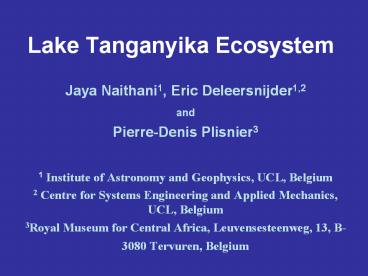Lake%20Tanganyika%20Ecosystem - PowerPoint PPT Presentation
Title:
Lake%20Tanganyika%20Ecosystem
Description:
Lake Tanganyika Ecosystem Jaya Naithani1, Eric Deleersnijder1,2 and Pierre-Denis Plisnier3 1 Institute of Astronomy and Geophysics, UCL, Belgium – PowerPoint PPT presentation
Number of Views:111
Avg rating:3.0/5.0
Title: Lake%20Tanganyika%20Ecosystem
1
Lake Tanganyika Ecosystem
- Jaya Naithani1, Eric Deleersnijder1,2
- and
- Pierre-Denis Plisnier3
- 1 Institute of Astronomy and Geophysics, UCL,
Belgium - 2 Centre for Systems Engineering and Applied
Mechanics, UCL, Belgium - 3Royal Museum for Central Africa,
Leuvensesteenweg, 13, B-3080 Tervuren, Belgium
2
East African Rift Lakes
3
General characteristics of Lake Tanganyika
SE winds
Mpulungu
Bujumbura
Kigoma
Mpulungu
(c)
(a)
(b)
i
ii
iii
4
Observations (April 93-March 94)
5
Model Layout
- Hydrodynamic component
- Non-linear reduced gravity equations
- Entrainment included
- Ecological component
- One nutrient
- Phytoplankton biomass
- Zooplankton biomass
- Detritus pool
6
Sketch of the reduced-gravity model
Z0
upwelling
Epilimnion
Hh?
h
?s
Depth
-?
Z-h
?
Hypolimnion
?b
downwelling
7
Hydrodynamic sub-modelcontinuity equation
- ? is the downward displacement of the thermocline
(m), - H h?, is the upper layer depth (m),
- h is the equilibrium depth of the thermocline
(m), - we is the entrainment velocity (m/s),
- x and y are the horizontal axis and t is the
time.
8
Hydrodynamic sub-model (contd.)continuity
equation (contd.)
- ?x and ?y are the horizontal components of
specific wind stress in x and y direction (m/s)2, - g is the gravitational acceleration (m/s2),
- ?(?b - ?s)/ ?b is the relative density
difference between bottom and the surface layers, - wd is the detrainment term (m/s),defined so that
the annual mean of the epilimnion volume remains
constant. - rtt is the relaxation time scale of the
thermocline (s).
9
Hydrodynamic sub-model (contd.) momentum
equations
- u and v are the currents in the x and y
directions, - f is the Coriolis factor,
- As is the horizontal eddy viscosity in the
s(x,y) direction, - Ay Ax(?y/?x)2
is the entrainment or detrainment term, ,
are momentum fluxes from epilimnion to the
hypolimnion.
10
Flowchart of the ecological model
z0 surface
Copepods
Phytoplankton
copepod grazing
predation
fecal pellets egestion
soluble excretion
mortality
respiratory release
uptake
mortality
dissolved organic phosphorus
pelagic detritus
epilimnion
Phosphate
pelagic regeneration
sinking
zH
Benthic detritus
benthic regeneration
hypolimnion
11
Ecological sub-model (Phytoplankton)
PROD
RESP
MORTa
GRAZ
SINK
- Phyto is the phytoplankton biomass in µgC/L,
- Ks is the horizontal eddy diffusivity in the
s(x,y) direction, - ?he is the flux of Phytoplankton from
hypolimnion to the epilimnion, - PROD is the gross primary production calculated
using the nutrient and light limitations, rp is
the maximum daily production per day. - F(I) and F(P) are the functions of light and
nutrient limitation. - RESP is the respiration calculated using the
percent of PROD. - MORT is the mortality is assumed to be
proportional to phytoplankton standing stock with
mortality rate mz per day. - GRAZ is the copepod grazing assumed to be
proportional to copepod biomass (Zoo) with rate
rz per day. - SINK represents the sinking phytoplankton per day.
12
Phytoplankton (contd.)
- Phos is the phosphate in µgP/L.
- Kphos is the half-saturation constant.
- ke(0.07 Phyto/1000.07 pa ma Phyto/100)0.077,
is the light extinction coefficient (m-1), - Ik is the light saturation constant (?Em-2s-1),
- Io is the photosynthetically active radiation
(?Em-2s-1).
13
Ecological sub-model (Zooplankton)
MORTz
EXE
FEC
PRED
- Zoo is the zooplankton biomass in µgC/L,
- ?he is the flux of zooplankton from hypolimnion
to the epilimnion, - EXE, FEC and MORT are the excretion, fecel
pellets egestion and mortality rates of
zooplankton parameterized as fixed proportion of
zooplantkon grazing (GRAZ).
(GRAZcopepods
growthEXEFECMORTz). - PRED is the predation of zooplanktons by
zooplanktivorous fish (FISH), which is considered
equal to zooplankton biomass.
14
Ecological sub-model (Phosphate)
REM
UPTAKE
REMsa
- Phos is the phosphate concentration in µgP/L,
- ?he is the flux of phosphate from hypolimnion to
the epilimnion, - REM is fractions of dead phytoplankton, fecal
pellets and the dead zooplankton that are
instantaneously remineralization within the water
column by the microbial food web. - Soluble Excretion by zooplankton and respiratory
release by phytoplankton directly replenishes the
phosphate pool. - CPa and CPz are the carbon to phosphate ratio of
phytoplankton and zooplankton, respectively. - REMsa is the remineralized percent of the sinking
phytoplankton.
15
Ecological sub-model (Detritus pool)
- Detr is the detritus concentration in µgC/L,
- ?he is the flux of detritus from hypolimnion to
the epilimnion, - rd is the detritus decomposition rate in the
water column. - wd is the detritus sinking rate in m/sec.
16
April 1993 to March 1994
17
Interannual Upwelling Intensity
Data
FAO-LTR
FAO-LTFMP
CLIMLAKE
18
Predictionsoff Kigoma and off Mpulungu 1970-2004
19
Lake averaged Predictions
290 gCm-2yr-1 Hecky and Fee (1981) 360
gCm-2yr-1 predictions
426-662 gCm-2yr-1 Sarvala et al., (1999) 300-450
gCm-2yr-1 predictions
20
Fish Target Species
Stolothrissa miodon
Clupeids Sardines
Limnothrissa tanganicae
Lates stappersi
Perch
21
Predictions and Fish Statistics
Bujumbura
B URUNDI
Kigoma
TANZANIA
RDC
N
Mpulungu
ZAMBIA
22
Conclusions
- The model satisfactorily predicts the dynamics of
primary productivity in Lake Tanganyika (350-400
gC/m2/year). The agreement between the
observations and prediction is encouraging. - Primary production, which depends strongly upon
light in the water column and entrainment of
nutrients, is bottom-up controlled. - At least phytoplankton chlorophyll concentrations
seem to have remained largely similar from the
1970s to the present except for some year to
year fluctuations due to exceptional winds. - Relationship between the mixing depth changes
(due to warming) and lake productivity is not
simple or straightforward. - Next I will explore the impact of increased
population around the lake.
23
Why study the past climate and link it with Lake
production!
To make future scenarios And plan for the
sustainable management of fisheries.































